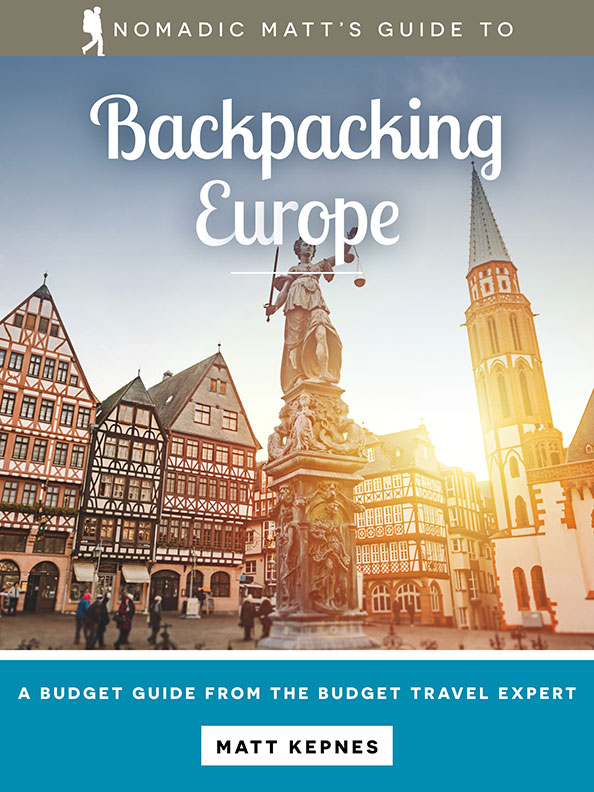
Several years back, when I was getting ready to move to Sweden, I wanted to find a way to bypass the 90-day limit imposed on tourist visas within the Schengen Area. This issue affects many travelers every year, and it’s a question I often receive via email.
“How can I spend more than 90 days in Europe?”
It’s a straightforward question, but the answer is quite complex.
I always thought it was intricate, but until I began to investigate how to extend my stay, I didn’t realize just how complicated it truly was.
Luckily, during my research, I uncovered several methods to remain in Europe for more than 90 days.
This article will outline the various options for staying in the Schengen Area beyond 90 days and offer advice on relocating to Europe for the long haul.
It’s crucial to understand that when people mention the “90-day limit,” they refer to regulations concerning the Schengen Area, a visa policy that governs 29 European countries. This includes most European Union members and a handful of non-EU nations.
Although I refer to it as the “Schengen Visa,” it’s not an actual visa that you always need to apply for. Depending on your citizenship and residency status, you might need to apply for a Schengen Visa ahead of time; however, U.S. passport holders do not have to do this in advance.
What is the Schengen visa?
The Schengen visa permits a 90-day visit to countries in the Schengen Area, which includes:
Additionally, there are several micro-states that are effectively part of the Schengen Area, including Monaco, San Marino, and Vatican City.
These Schengen nations have a border-free agreement enabling residents to travel throughout the Area without needing to show their passports each time they cross a border. Essentially, they function as a single country, allowing for seamless travel.
Citizens from numerous countries can enter the Schengen Area without needing to secure a visa beforehand. Upon arrival and departure from Europe, your passport simply gets stamped. You can enter and exit from any country, and they don’t have to be the same. (You can find a map of countries that have visa waivers and can enter the Schengen Area without needing a visa in advance.)
Most visitors (including those from the U.S.) can stay in the Schengen Area for 90 days within every 180-day period. A simple way to think about this is that you can visit for three months, and then you must leave for three months before returning. Remember, nationals from various countries need to obtain a Schengen visa in advance. This entails filling out paperwork and entering/exiting through the country from which the visa was issued, so be sure to check the requirements for your nationality. (Spoiler: Citizens from many African and Asian countries often face difficulties.)
How does it work?
Your initial entry within the 180-day period starts your 90-day countdown. These days don’t need to be consecutive — the total accumulates. Once you reach day 181, the count resets.
For instance, if I enter the Schengen Area in January and stay for 60 days, then return in June for 10 days, that totals 70 days within 180 days. Only the days spent in the zone during that period count. If you depart on January 1st and stay for 90 straight days, you must leave and technically cannot re-enter until July 1st.
If you frequently travel, consider using the EU’s Schengen visa calculator. Just input all your travel dates, and it will tell you how many days remain.
If you stay beyond your 90 days, you could face fines or even deportation, along with a potential re-entry ban to the Schengen Area. Enforcement of this rule varies widely from one country to another. Overstaying by a day might be overlooked in some nations, while others are stringent about such offenses.
For instance, Germany, the Netherlands, Poland, Switzerland, and Scandinavian countries strictly enforce entry and exit regulations. If you overstay your visit, there’s a high chance you’ll be questioned. I know two Australians who were detained when leaving Switzerland for exceeding their visa by two weeks. They were allowed to leave after receiving just a warning but missed their flights and had to arrange new travel plans.
Alternatively, someone I know overstayed by six months and faced an “illegal immigrant” stamp on their passport when attempting to leave from Amsterdam. To return to Europe, they now must secure a visa at an embassy and obtain pre-approval.
Another traveler shared a similar experience:
I mistakenly tried to leave the Netherlands after overstaying a Schengen visa and was stopped. I had overstayed by about a month, and they drew a mark in my passport to indicate the overstay. I was instructed to contact IND regarding my ability to enter Schengen states again.
That said, if you leave from Greece, France, Italy, or Spain, you might encounter fewer issues, provided you (a) haven’t overstayed significantly and (b) don’t face an immigration officer with an agenda.
When I departed Greece, no one even glanced at my passport. A friend met someone in France and fell in love, ultimately deciding not to leave. When she finally left a year later, French officials didn’t bat an eye. Spain is also known for being lenient, and Americans who overstay often report it being the easiest country for exit.
Of course, I wouldn’t recommend overstaying your visa. A day or two might go unnoticed, but a few weeks or months elevate the risk of serious consequences. The fines can be hefty, and do you want to risk a ban from most European nations? I doubt it!
But, Matt, isn’t it possible to extend my Schengen visa/stamp?
Sadly, no. You cannot extend your tourist visa or entry stamp. The 90-day limit is firm.
So, how DO you stay in Europe for longer? Let’s break it down:
Part 1: Easy Ways to Stay or Move to Europe


Given the varied visa regulations, it’s quite feasible to remain in Europe for longer than 90 days as a tourist — you just need to switch up the countries you visit. The United Kingdom has its own stipulations, allowing stays of up to 180 days in a calendar year.
Most non-Schengen countries, like Moldova, Ireland, and certain Balkan nations, permit visits of 60 to 90 days. Albania even allows Americans to stay for an entire year!
To extend your time in Europe beyond three months, just spend 90 days in the Schengen Area, then head to the UK, explore the Balkans, enjoy wine in Moldova, and have a pint in Ireland. If planned correctly, you can easily exit the Schengen Area for 90 days and return with a fresh Schengen visa.
In the past, to navigate this limit, I spent three months in Bulgaria (which wasn’t a member then; it joined in 2025), Romania (also not a member at that time), Ukraine, and…
England as I waited for my clock to reset.
If you’re looking to explore Europe for an extended period without navigating through complicated visa requirements, consider visiting non-Schengen nations. There are plenty of locations to explore while waiting for your Schengen Visa timeline to refresh. This method is straightforward and free of stress.
However, if this is your traveling strategy across Europe, it’s crucial to secure travel insurance. For just a small daily fee, you can protect yourself in case any issues arise during your journey. I usually recommend SafetyWing as my travel insurance provider. Their Nomad Insurance is budget-friendly and provides coverage for delays, lost luggage, and interruptions (which are common when traveling between different countries). Additionally, it offers $250,000 in emergency medical coverage, preventing you from facing enormous costs in case you require medical help. Their customer support is also impressive, making it easy to file claims or get inquiries answered.
Part 2: Extending Your Stay in the Schengen Area Beyond 90 Days


What if you wish to remain longer in the Schengen Area? What if all six months of your European adventure include only Schengen countries? What if your intention is to live or work in Europe?
The Schengen Area comprises 29 nations, and trying to see so many places in just 90 days can be a bit overwhelming (you would average only about 3.1 days per country).
If you’re aiming to stay longer for travel, work, language learning, or even romantic pursuits, simply moving around as mentioned earlier won’t suffice. You need an alternative plan.
Fortunately, there are several options available to you:
1. Utilize the Bilateral Agreement


Beyond the typical Schengen visa, numerous countries also possess bilateral agreements outside of it. These agreements can permit travelers to remain in a specific nation for an additional period beyond the usual 90-day limit. The catch is you cannot leave that country during this time.
For instance, France has a bilateral agreement that allows U.S. citizens to extend their stay for an extra 90 days beyond the Schengen limit. You can enter from any Schengen country, stay 90 days in France, and then head home. However, the stipulation is that you must leave Europe afterward; you can’t use your time in France as a loophole to reset your Schengen timeline.
This France/U.S. arrangement is quite complex. It stems from a post-World War II agreement that hasn’t been annulled. Several French consulates confirmed its existence, though finding specific documentation took considerable effort. Various visa services didn’t acknowledge my inquiries, and some consulates suggested it was only attainable through a long-term visa.
After numerous discussions, the US, Canada, and UK French embassies confirmed this law is indeed valid and directed me towards the French national archives for the official documentation.
Eventually, I discovered the relevant diplomatic documents that clarify this arrangement, which took nearly a year of research.
Here’s what two embassies indicated:
Hi,
There exists a bilateral agreement between France and the U.S. (established via letters dated March 16-31, 1949), permitting American citizens to stay in France for 90 days within 180 days, regardless of their stays in other Schengen nations.
This agreement predates the Schengen arrangement. Given the current lack of border control amongst Schengen countries, it’s become challenging to track a person’s stay duration in France, and we have heard of individuals encountering issues with immigration upon exiting France.
We thus advise American citizens to adhere to Schengen regulations, allowing a maximum of 90 days within 180 days across the entire Schengen area.
Consulat général de France, Service des visas
4101 Reservoir Road, Washington DC, 20007
A follow-up with the London embassy produced this reply:
“While the bilateral agreement you mentioned has not been officially revoked, the French Border Police possess the exclusive authority to decide on its application when entering or leaving the Schengen area.”
This arrangement is indeed legitimate. Though it’s not heavily endorsed, it remains the prevailing law. Just make sure to carry proof of your stay in France for 90 days! If you plan to utilize this rule, have documentation on hand, as border officials may not be familiar with it. I leveraged this rule during my stay in Paris in 2019, and one of the readers of this site confirmed they used it this year as well. It still holds up!
Furthermore, Denmark, Norway, and Poland also have bilateral agreements with the United States allowing extended stays of an additional 90 days in each respective nation, independent of the standard Schengen visa. The same conditions that apply in France also pertain to Denmark. Additionally, Denmark has a similar agreement for citizens from Australia, Canada, Chile, Israel, Japan, Malaysia, New Zealand, Singapore, and South Korea.
However, travelers may only take advantage of either the Norwegian or Danish agreement—using them concurrently is not permissible (time spent under one counts towards the other).
For Poland, entry and exit must be conducted via a non-Schengen country where you will be stamped anew (for example, a direct flight from NYC). Therefore, you could spend 90 days in Schengen, travel to the UK, and then fly to Poland. Poland’s stipulations are clearly outlined in an agreement letter signed by the U.S. and Poland in 1991. (Here’s the official letter from the Polish government.)
In theory, there are other bilateral agreements between the U.S. and various Schengen countries. I’ve been informed by multiple sources that Belgium, Italy, Hungary, Norway, Spain, Portugal, and the Netherlands also maintain similar agreements with the U.S. This page summarizes the existing bilateral agreements.
However, I reached out to consulates from each of these nations, and aside from Portugal, the responses were generally unhelpful, directing me back to standard visa FAQ pages.
Regarding Portugal, a representative from their consulate mentioned this concerning their 60-day bilateral visa:
Keep in mind that those 60 days are an exceptional extension that must be applied for within Portugal at the SEF office close to your temporary residence in Portugal.
Theoretically, one might argue that with seamless travel, you could secure your “extra 90 days in Denmark” and then roam freely, departing from Denmark without raising any suspicion. One might argue this. However, I’ve noticed increased passport checks within Europe in recent years, so I wouldn’t advise trying this.
Note: Most countries maintain bilateral agreements with others. It’s wise to contact the local embassy for more information (calling is usually more effective than emailing).
2. Obtain a Working Holiday Visa


Obtaining working holiday visas is straightforward and a great option for prolonging your stay—even if you don’t intend to work. These visas cater to young travelers eager to both work and travel internationally. Citizens from Australia, Canada, New Zealand, and often from South Korea, Israel, Hong Kong, and Japan can apply for one- to two-year working holiday visas from many Schengen nations.
There is no unified “working holiday” program across the Schengen or EU, so applicants must apply for their visa through a specific nation. Generally, applicants should be under 30, although age limitations have become more flexible recently. Furthermore, this visa restricts you to working only in the country that issued it.
You may also obtain consecutive working holiday visas. For instance, one of my Australian readers received a two-year working holiday visa from the Netherlands and then another from Norway, allowing her to extend her stay by another two years. While she and her boyfriend took on some casual jobs in the Netherlands, they primarily used their visas to travel across Europe.
For American citizens, there are just two working holiday options in Europe: Ireland (a non-Schengen territory) and Portugal (part of the Schengen zone). Both programs are quite similar, granting a 12-month work visa to those who are currently enrolled in or have recently graduated from a higher education institution.
Applicants need to be at least 18, with no upper age limit as long as they meet the other requirements. With the Portuguese visa, you’re permitted to work for only 6 months out of the 12, or study for 4 months, while the Irish visa has no such restrictions.
A technically third option exists for Austria, however, applicants must have graduated within the past year. Moreover, only 100 visas are allocated annually, making it a challenging option.
3. Obtain a Long-Term Visa


Unfortunately, most Schengen countries do not provide long-term visas for visitors who are not working in the country they wish to stay in. Generally, obtaining a long-stay visa requires applying for a work visa or residency, which can be a lengthy bureaucratic process involving significant paperwork.
If you operate a fully online business, many countries now offer digital nomad visas, as long as you earn a specific monthly income and have valid health insurance. More details on this will follow in a later section.
The Schengen agreement allows for either a C- or D-class visa (the letter depends on the issuing country), functioning as a temporary residence visa valid for up to one year. The exact visa type and conditions differ by country—some are relatively easy to obtain, while others can be quite challenging despite being part of the same visa treaty.
However, there are a few countries that do offer accessible long-term visas:
France
France provides a long-term visitor visa extending for up to one year. As per the French Embassy, “The ‘visitor’ visa (or visa ‘D’) allows entry into France for stays beyond three months. Holders of a long-stay visa are permitted to live in France for a maximum of 12 months, depending on the validity of their visa and the reason for their stay.”
To apply for this visa, you need to make an appointment at your local French consulate. Walk-ins are not permitted; an appointment is necessary.
At the appointment, you’ll need the following items:
- A completed and signed visa application form
- ID photographs
- Your original passport, issued within the last decade, valid for at least three months post-return, and with at least two blank pages
- A notary-certified letter affirming that you will not work while in France
- A letter of employment indicating your current position and salary
- Income verification (e.g., a pension certificate or the last three bank statements)
- Proof of medical insurance including evacuation coverage and at least 30,000 EUR in medical support (your US health insurance card will not suffice; detailed information on coverage is necessary)
- Accommodation proof in France (if lacking official documentation like a sublet agreement, a letter outlining your lodging arrangements will do).
Note: Applications cannot be submitted more than three months before your intended arrival.
For comprehensive information, you can visit the official France-Visas website, which outlines all visa types and includes a “visa wizard” guiding you based on your situation, along with necessary documentation details. The application fee for this visa is 99 EUR.
You may also access the French Embassy website for local contact information.
Sweden
Sweden offers a long-term tourist visa valid for up to one year. Here’s what you’ll need:
- Application form for a residence permit for visitors
- Copy of the passport pages showing your identity and the validity details, plus copies of all your other visas or entry stamps. Your passport should also be valid for three months following your visa.
- A bank statement confirming your ability to support yourself during your stay (450 SEK for each day you’ll be there)
- A return flight ticket
- Proof of medical travel insurance for at least 30,000 EUR
Most applicants for this visa have family in Sweden. If you don’t, you’ll need compelling reasons for an extended stay and must demonstrate substantial proof of financial self-support (e.g., “I want to meet Swedish friends” won’t suffice!). The application fee is 1,500 SEK.
You can apply from both within Sweden or from abroad. If applying within Sweden, you may submit your application online and then book an appointment to verify your passport and provide fingerprints. Conversely, applying from outside requires an in-person application at the consulate or embassy, during which you’ll also discuss your trip purpose.
Further detail on the process can be found on the official government webpage.
Planning a trip to Europe?
Check out all my top travel tips along with these resources:
- Travel Planning Basics
- 61 Smart Travel Tips
- Recommended Hostels in Europe
- My Favorite Travel Companies
- How to Secure Free Flights to Europe
Enter your details below to receive your FREE guides today!
Spain
Until 2025, Spain provided various…
There are various types of long-term visas available. The first is the Golden Visa, which requires a significant financial investment in Spain. This can involve investing at least 1 million EUR in a company, 500,000 EUR in real estate, or funding a new business in sectors like science or technology that generates local jobs. However, this option was discontinued in 2025.
An alternative, more accessible long-term visa for retirees is the Non-Lucrative Residence Visa. This visa mandates that you reside in Spain for a minimum of 183 days, establishing you as a legal resident for tax purposes. While you can’t work during this period, you’re allowed to engage in studies or unpaid internships.
The main requirement for this visa is a yearly income of at least 55,000 EUR (more is preferable). If you’re not employed, you should have at least this amount in savings or income from a pension each month.
Additionally, when applying for this visa, you must complete an application, submit your passport and photos, pay a fee, and provide the following:
- Evidence of private health insurance from a recognized company in Spain (not travel insurance)
- A medical certificate confirming your health status
- A criminal background report translated into Spanish
You must apply for this visa from your country of residence, usually with legal assistance. The application fee for U.S. citizens is $151 USD.
For further details regarding the application, refer to this consulate page.
If you are a digital nomad, keep in mind that Spain introduced a digital nomad visa in 2023. This option has a lower income threshold (30,000 EUR annually) and shares similarities with the application process. More information is available here. (Details on remote work visas are provided below.)
Portugal
Portugal also offers several long-term visa options. The Golden Visa requires a minimum investment of 280,000 EUR (investments can be through funds, cultural donations, or job creation). This option is often unattainable for those without significant wealth.
The D7 Passive Income visa, also known as the Retirement or Passive Income Visa, resembles Spain’s non-lucrative visa. This is a more feasible choice for many applicants. To qualify for this visa in Portugal, you need:
- Health insurance proof
- A clean criminal record
- Evidence of financial stability (a yearly income of 8,460 EUR)
- A letter explaining your intentions in Portugal
- Two passport photos
- Accommodation proof
The primary distinction between the long-term visas in Portugal and Spain is that the required income in Portugal is significantly lower at around 8,460 EUR, making it more attainable.
The D7 visa is also applicable for digital nomads, as it is valid for four months. Portugal is more accommodating of remote work income for visa applications compared to Spain.
Additionally, Portugal has the D2 immigrant Entrepreneur visa, which, while not exclusively for digital nomads, could be suitable for certain entrepreneurs. Applicants must present a business plan and demonstrate sufficient capital to launch their venture. Articulating the reason for establishing or relocating a business in Portugal increases your chances of approval, especially if you’ve invested over 5,000 EUR and possess some knowledge of Portuguese (not mandatory, but beneficial as these visas are commonly rejected).
In summary, there are several steps involved in acquiring a temporary visa. However, you have the option to extend this visa and eventually apply for permanent residency or citizenship after five years.
Both of these visas need to be obtained from your country of residence.
The official Portuguese visa website provides further details on specific visa types and their requirements. You can find your nearest Portuguese consulate here.
A note on long-term visas: It’s important to remember that the information shared here is for reference. Additional requirements may apply and not every visa is accessible to all applicants. Be sure to reach out to your local embassy for specifics and further information.
4. Acquire a Student Visa
Every country in the Schengen Area provides student visas that are relatively easy to obtain if you’re enrolled in an accredited university program. You’ll need to pay for your courses and possibly demonstrate minimum financial requirements, but acceptance into a program nearly guarantees you a visa.
Spain is among the top countries for this, boasting numerous institutions geared toward teaching Spanish. Many schools offer enrollment and provide letters confirming your student status. The application must be submitted in your home country, but the process is fairly straightforward. This post outlines the requirements.
Germany is another attractive option, as public post-secondary institutions are mostly tuition-free. While the competition may be higher, the expenses are significantly lower. You’ll need to provide evidence of having sufficient funds in a bank account—specifically, 11,208 EUR in a blocked account.
Additionally, in Germany, you may be allowed to work for a maximum of 120 full days, or 240 half days (20 hours per week) while studying as well. You can explore the application process here.
While most student visas permit a stay of up to one year, it’s advisable to consider obtaining one only if you genuinely intend to study. If your goal is simply travel and tourism, the costs and paperwork involved, which include securing a residential address, bank account, and local phone number, may not be worthwhile.
5. Obtain a Freelancer/Digital Nomad/Remote Worker Visa
A number of countries now offer freelancer visas geared towards the growing remote workforce. This process is a bit more intricate and is not meant for casual tourists. These visas cater to individuals who genuinely wish to live and work in Europe. If you’re just looking to visit, be prepared for a potential denial. However, if you can provide proof of income as a digital nomad or remote worker, this visa option is perfect for you. Countries in Europe offering freelancer or remote worker visas include:
- Albania
- Croatia
- Cyprus
- Czechia
- Estonia
- Finland
- Germany
- Greece
- Hungary
- Iceland
- Italy
- Latvia
- Malta
- Norway
- Portugal
- Spain
- Romania
- Turkey
Germany is frequently chosen by those wishing to reside in Europe. For freelancers, digital nomads, artists, or anyone with a reliable income, this visa is ideal. If you hail from Australia, Canada, New Zealand, the U.S., Israel, South Korea, or Japan, you can apply upon your arrival in Germany (others need to apply beforehand).
The German freelancer visa is only valid for three months, but it’s intended to be converted to a residency visa, which can last for three years. Many of my acquaintances have successfully obtained this visa. Following the correct procedures increases your chances of approval. More details on the process can be found in this post.
Most of these visa types generally require similar steps: submitting an application, paying a fee, demonstrating the viability of your business, and waiting for acceptance. However, certain visas may have more stringent criteria.
For digital nomads considering remote work within the EU, you can compare these programs to find the best fit for your objectives (Germany tends to be the most favorable option).
This is a great option as it’s one of the simplest to obtain.
6. Tie the Knot
Why not fall for a European (or at least someone friendly) and pursue a marriage visa? You can remain in the country while your application is processed, allowing you to start a new life in Europe with your partner! It’s a win-win! (Just kidding—please don’t marry solely for a visa!)
The most efficient and straightforward way to enjoy a long-term stay in Europe is to maximize your visits to various countries, ensuring that you stay within the Schengen Area’s 90-day limit. Many countries aren’t part of this Area, making this approach manageable.
If, like me, you want to extend your time in the Schengen Area beyond 90 days (or simply want to embrace life in Europe), get ready to navigate the system wisely. It is feasible to stay long-term in the Schengen Area. By familiarizing yourself with the regulations and taking advantage of any available loopholes, you can legally remain beyond the 90-day mark and relish all that Europe has to offer without fear of being barred from returning.
Grab Your Comprehensive Budget Guide to Europe!


My extensive 200+ page guidebook is tailored for budget-minded travelers like you! It eliminates the unnecessary details found in other guides and focuses on essential tips for navigating Europe. You’ll find recommended itineraries, budget suggestions, money-saving strategies, hidden gems, local dining, markets, bars, safety advice, and much more! Click here for more information and to get your copy today.
Plan Your European Adventure Like an Expert
Receive all my top travel tips for Europe along with free planning resources, so you can explore even more of the continent for less!


Plan Your Trip to Europe: Essential Tips and Tricks
Find Flights
Use Skyscanner to discover affordable flights. It’s my preferred tool because it searches numerous websites and airlines globally, ensuring you find the best deals!
Reserve Accommodations
Consider using Hostelworld to book your hostel, as they offer the largest selection and best prices. For alternatives to hostels, Booking.com usually provides the lowest rates for guesthouses and budget hotels.
Remember Travel Insurance
Travel insurance protects you against sickness, injuries, theft, and cancellations—essential coverage if things go awry. I ensure to have it for every trip, and I’ve relied on it multiple times. My top recommendations for value and service include:
Seeking the Best Money-Saving Companies?
Visit my resource page where I list the best companies I use while traveling to save money. They can help you do the same.
Want More Insights on Europe?
Check out my comprehensive destination guide on Europe for additional planning advice!
NOTE: Given the complexities surrounding visas and individual circumstances, we cannot address any visa-related inquiries in the comments or via email. Thank you.


